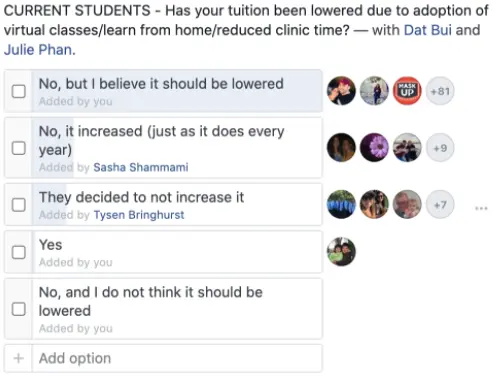The New Normal – Should Optometry School Tuition be Reduced in Light of Virtual Classes and Reduced Clinic Time?

KEY POINTS:
-
(1) With the increase in distance learning and decrease in in-person learning and activities, wouldn’t this decrease overhead and thus allow optometry schools to operate at a lower level of total expenditures?
-
(2) News reports have stated that many major universities are discounting tuition for the upcoming Fall 2020 term, with an average tuition rate lowering of $7000.
-
(3) Unsurprisingly, the majority of OD student voters stated that their tuition has NOT been reduced, but they believe it should. A surprising minority stated that their schools actually raised tuition this year despite the new changes that were made in light of the pandemic.
-
(4) Professors explain that costs for continuing the education of our students has gone up during this time of remote education, not down, due to investment in more robust technology to support virtual learning, purchased tons of PPE and sanitizing supplies to keep the university safe and cut labs in half so we have to teach twice as many for the purposes of social distancing.
-
(5) We recommend having an open discussion between students and the school's financial department. Ask them if there is any way tuition prices can temporarily be reduced due to current events, or if there is any other type of financial aid they can provide. Start an open and honest dialogue.
The coronavirus pandemic has turned our world upside down. Face coverings and hand sanitizer, once foreign objects only wielded by the most righteous germaphobes, have now become a reality and requirement for nearly everyone. In the SF Bay Area, where ODs on Finance’s physical headquarters are located, many large tech companies have adopted a permanent work from home policy - which has lightened morning traffic, allowed many workers to move out of the area into more affordable areas and has undoubtedly reduced overhead cost for these large companies in terms of commercial real estate needs.
One factor that has drastically been affected by the pandemic is schooling and how learning is being conducted. Optometry schools in particular have witnessed one, some or all of the above following happening to their programs:
- Didactic classes moved to online only platforms
- Zoom calls for office hours, conferences, classes and club meetings
- Socially distanced wet labs
- Alternating in person activities
- Reduced clinic schedules
- Cancelled clinic schedules
With the increase in distance learning and decrease in in-person learning and activities, we began to wonder - wouldn’t this decrease overhead and thus allow schools to operate at a lower level of total expenditures?
But then we decided to play devil’s advocate. Was this adoption of technology and less in person contact resulting in professors working longer hours to create lessons that can resonate through video and audio lectures? What about administering testing and setting up a platform or portal for students to access study materials and exams?
News reports (from Forbes and US News & World Reports) have stated that many universities are discounting tuition for the upcoming Fall 2020 term, with an average tuition rate lowering of $7000.
So the big question that rears its ugly head is this: Should schools temporarily reduce tuition due to the adoption of virtual learning and reduced clinic/lab time?
Public Opinion
The ODs on Finance community has many current optometry students that are concerned with their finances, and we decided to take a poll:
Unsurprisingly, the majority of student voters stated that their tuition has NOT been reduced, but they believe it should. A surprising minority stated that their schools actually raised tuition this year despite the new changes that were made in light of the pandemic.
The poll also caused a bit of controversy. After posting the poll, we received many private messages from both admin/faculty and students, as well as a few opinions on the comment thread attached to the poll.
One message we received from an anonymous optometry school professor seems to sum up the takes from most school associated staff and faculty messages:
“Our costs for continuing the education of our students has gone up during this time of remote education, not down. We have invested in more robust technology to support virtual learning, purchased tons of PPE and sanitizing supplies to keep the university safe and cut labs in half so we have to teach twice as many for the purposes of social distancing.”
This professor went on to say: “I agree that higher education costs are out of control, but I am telling you that much of that is in variables that reside outside of our control. Never in the history of my working at our school have we ever approached anywhere near a 6% salary increase. My heart bleeds for students and their level of indebtedness, but we are agonizing over costs and are trying our [best] to be good stewards of their education and tuition dollars. I respect what you have done here and think it is a worthy conversation. I just wanted you to know that there is another perspective.”
On the other side, students voiced opinions regarding the impact that our new normal has had on their educational experience. One anonymous student stated:
“Our school has argued that since we are taking the same credit load, there will be no decrease in tuition cost. Even though all our classes have moved to online.”
Another anonymous student explained that “All our classes have moved to a blended format and our tuition also got raised next year.”
Many students informed us that they have in fact reached out to their school’s administration and have been met with vague answers or some variation of “we’re working on it.”
Open the Dialogue!
Below is a table of ideas we’ve compiled from both sides stating what each side should consider doing:
School Admin
Students
Here’s Our Take
ODs on Finance was founded because we believe that a solid financial basis will not only lead to healthier, happier and fulfilled optometrists, we also firmly believe that an optometrist who is confident in his/her finances will be able to more freely advance our profession and advocate for its growth.
Starting debt at the beginning of an optometrist’s career is like being a competitor in the Olympic 400 meter dash, but starting 100 meters behind the starting line. With the average optometry school tuition reaching ~$250,000 total and new OD salaries starting at around $120,000 per year, this places new grads in a huge debt to income ratio hole that eclipses 2:1 and may even reach 3:1 (depending on what type of job the new grad lands and what other expenses were taken out during school). Anything optometry schools can do to mitigate this metaphorical back tracking, will help the future of our profession immensely by reducing starting debt.
Now let’s be clear - we are not advocating for schools to reduce tuition in any way that would compromise either the quality or ethics of the education it provides. We realize that schools are trying their best to operate in ways that benefit their students and our profession as a whole, however those in accounting and managing positions at these institutions should really ask themselves: is there anything we can do to help these students? Can we make reductions feasible without compromising the quality and integrity of our education system?
And how about the students? We recommend asking! Talk to staff members in your school’s financial department. Ask them if there is any way tuition prices can temporarily be reduced due to current events, or if there is any other type of financial aid they can provide. Start an open and honest dialogue. The more individuals that speak up, the more school officials will take notice and possibly be willing to work with students.
"With the average optometry school tuition reaching ~$250,000 total and new OD salaries starting at around $120,000 per year, this places new grads in a huge debt to income ratio hole that eclipses 2:1 and may even reach 3:1 (depending on what type of job the new grad lands and what other expenses were taken out during school). Anything optometry schools can do to mitigate this metaphorical back tracking, will help the future of our profession immensely by reducing starting debt."
Want to learn how to manage your Student Loans? Check out The Optometrist's Guide to Student Loans
Want to get a full blueprint on How to start? Buy our Book The Optometrist's Guide to Financial Freedom


Facebook Comments